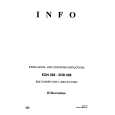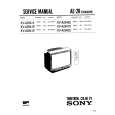|
|
|
Productos
|
|
Información
|
|
Destacado
|
|
|
 |
|
|
No hay comentarios de productos.
6-11. TROUBLESHOOTING
6-11-1. Cannot Enter Test Mode
You cannot enter the Test mode when either button has been pressed by any reason with the board assembled in the front panel. In this state, the power does not turn on even under normal condition (the unit is kept in standby state), and also no button is active and the remote commander is not accepted. In this case, disconnect the MB-107 board and with the SELF CHECK (pin 0) of IF CON (IC203) on the FL-129 board kept in low state, supply AC, and the IF CON self-diagnosis mode will be forcibly activated. The IF CON (IC203) checks the SELF CHECK port only after the power on reset (only at AC supply, not in standby state). If any button is pressed, its name is displayed on the fluorescent display tube. But, if other than �NOTHING� is displayed though no button is pressed, it means that any button has been pressed.
Measure the clock signal frequency at CPUCK (CL102) of SYSCON (IC104) with an oscilloscope. If the 8.25 MHz signal appears. t Check the machine according to section 1-3-1 If the 33 MHz signal appears. t Check the machine according to section 1-3-2. If other frequencies are output. R106 and R107 have defective soldering, X101 crystal oscillator is defective. If the measurement point is fixed to either �H� or �L�. t Observe XFRRST (pin-uh) of SYSCON (IC104) with an oscilloscope. If the measurement point is �L�, check the following items. If the IC has defective soldering, if the IC is short-circuited. If the measurement point is �H�, t Component X101 or SYSCON (IC104) is defective. 1-3-1. When the 8.25 MHz signal appears at CPUCK � Check the XRD, XWRH and CS0X signal. Observe XRD (pin-u;), XWRH (pin-ua), and CS0X (pin-tk) of SYSCON (IC104) with an oscilloscope. If these pins are fixed to either �L� (0V) or �H� (3.3V), or if these pins stay in the center voltage, check the followings. Check if the signal line does not have the defective soldering. Check if the signal line is short-circuited with other signal lines. If you cannot find any problem t SYSCON (IC104) is defective. � HA [0 to 21] signal and HD [0 to 15] signal check Observe HA [0 to 21] (pins-<z/x to <z/. , <zzz to <zz, , <zx/ , 1 to 5) of SYSCON (IC104) and HD [0 to 15] (pins-ig to <z// ) with an oscilloscope. If these pins are fixed to either �L� (0V) or �H� (3.3V), or if the HA pin stays in the center voltage, check the followings. (HD stays in the center voltage when it is normal.) t Check if the signal line does not have the defective soldering, or is short-circuited with other signal line or SYSCON (IC104) is defective. � Reset signal check Check if XFRRST (pin-uh) of SYSCON (IC104) normal or not. The signal starts up at the same time as Vcc t Defective soldering. If the trouble does not apply to any of the above-described phenomenon, SYSCON (IC104) or ROM (IC106 or IC107) is defective. 1-3-2. When the 33 MHz signal appears at CPUCK
6-11-2. Faults in Test Mode (MB-107 board)
1. The test mode menu is not displayed. 1-1. Board visual check Check that the ICs of SYSCON (IC104), ROM (IC106 or IC107), AVD (IC403), ARP & SERVO (IC301) are working correctly. Check that outside appearance of the ICs is normal. Check that IC pins are not short-circuited. Check that there is no soldering error. Check that outside appearance of the capacitors and resistors is normal. 1-2. Power supply voltage check Check the power voltage of the power connector (CN101). Check the power voltage of SYSCON (IC104). Check the power voltage of ROM (IC106 or IC107). Check the power voltage of AVD (IC403). Check the power voltage of ARP & SERVO (IC301). If the power voltage has any abnormality t Check that the power supply lines are not shorted. Check that there is no soldering error. If any abnormality cannot be found still t Check that each IC is working normally. 1-3. Clock signal check
6-20
|
|
 |
> |
|





